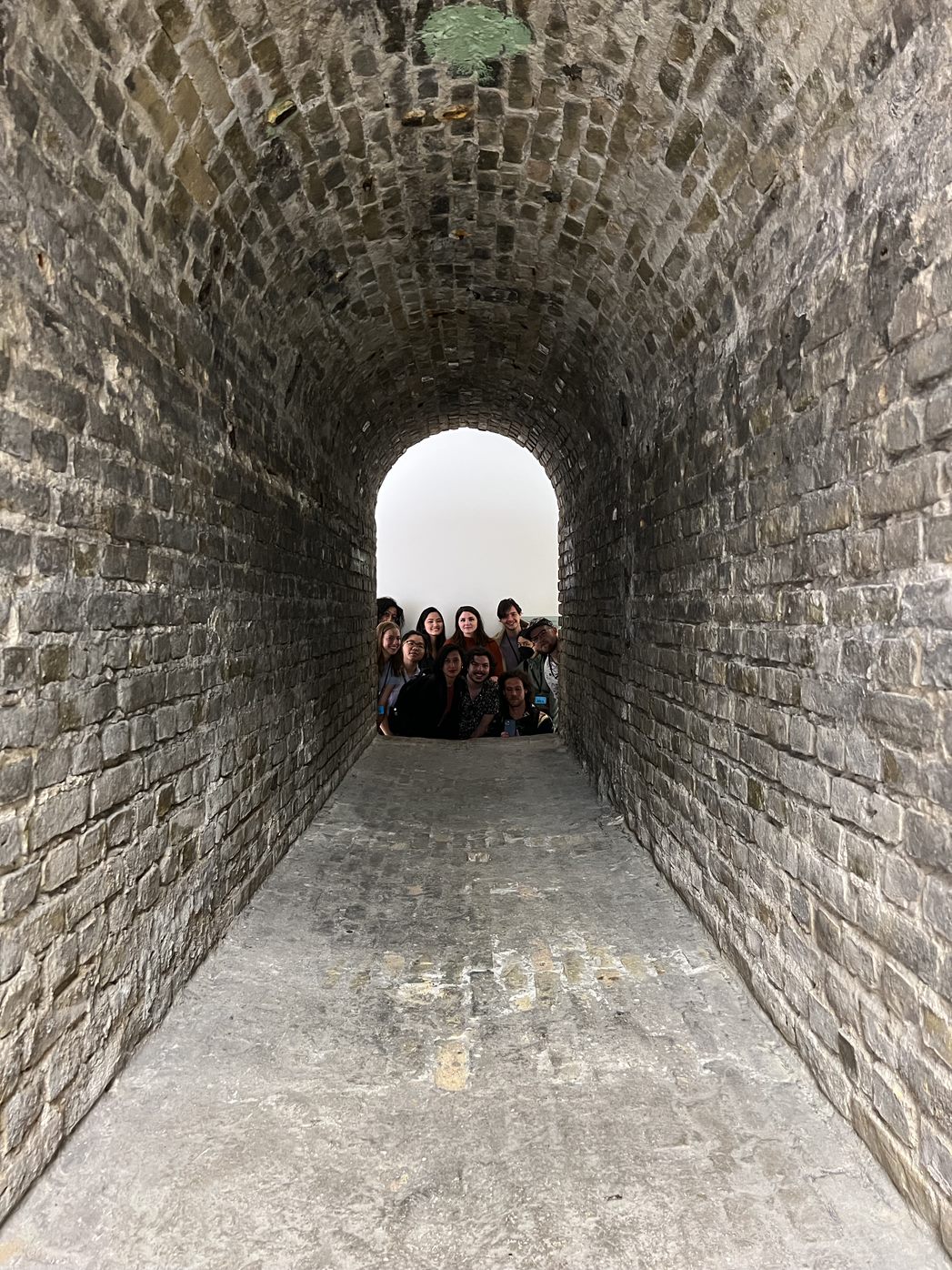
An underground tunnel used to lead out of the Reichstag. (Photo by Patricia Olynyk)
Artists reckon with history every day—but seldom does their government share their concerns. Germany is different. There, the state supports and even sponsors controversial art. Public places deliberately preserve even the darkest shame. History is not allowed to be forgotten. And artists—even those who come from other places to be part of Berlin’s arts community—engage that history in their contemporary work.
The art and conversation this openness makes possible have turned Berlin into one of the world’s most important international art cities. And that is why, for the past ten years, Patricia Olynyk, the Florence and Frank Bush Professor of Art at Washington University’s Sam Fox School, has brought groups of students overseas for a seminar called the Berlin Sommerakademie.
They are given a private tour of the Memorial to the Murdered Jews of Europe, led by a guide who whose entire family was killed. They meet with artists whose names they have only seen on syllabi, talking with them in their studios or simple, unpretentious Berlin apartments, seeing what artists they collect. They hear the latest conversations among artists, architects, curators, gallerists, art historians, collectors. They see VR work individually just after its installation in the Jewish Museum, and they visit the Berlin Biennale with a private guide. They are dizzied by the Venice Biennale, nothing like it in the United States. They picnic on the old America air base, Temple Hall.
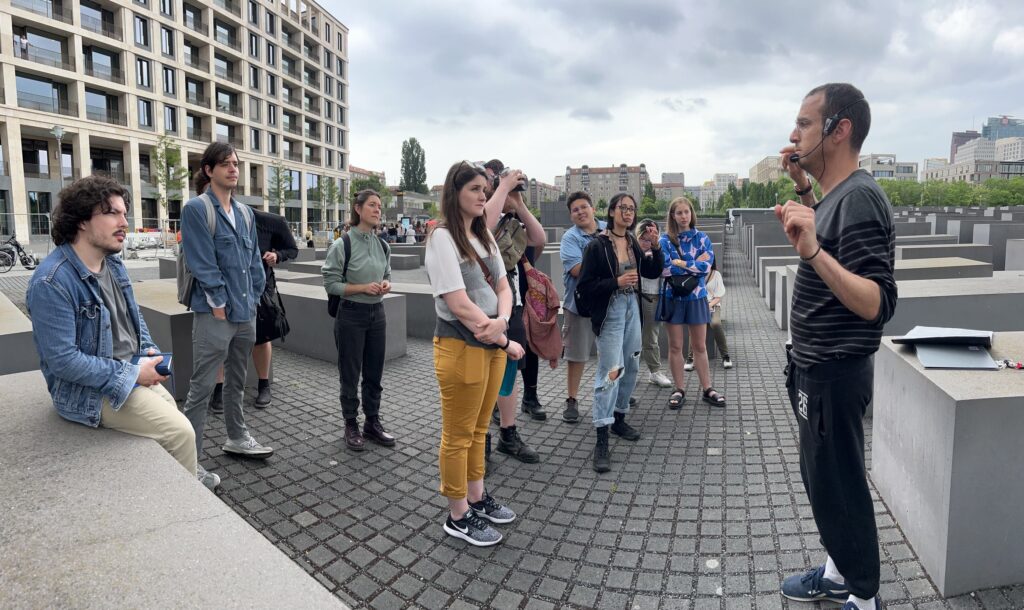
Private tour of the Denkmal, Memorial to the Murdered Jews of Europe. (Photo by Patricia Olynyk)
Dr. Thomas Lutz, a director at the Topography of Terror Foundation who oversees Berlin’s memorial museums, introduces the young artists to Berlin’s Nazi past. Then he reminds them of its relation to slavery in the United States, which Hitler studied carefully.
“Seeing the Third Reich as other has been a comfortable position for people who were not German-born,” Olynyk notes. “But when you start to talk about Nazi crimes in relation to the history of U.S. slavery, you see there’s something larger about human nature, culture, and politics that plays out in horrifying ways. It’s not an isolated phenomenon.”
The experiences that are possible in Berlin are powerful and unsettling; they grab hold, forcing you to wrestle with them. Olynyk gives the students thick course packets to read before and after each visit: one compilation on memorials and monuments, and another on how Berlin’s traumatic past factors into contemporary debates. They crowd into her Airbnb every few days to debrief, compare notes, explore ideas.
What the students learn in Berlin also folds into Olynyk’s own work. A fellow in The Medicine & Media Arts Initiative at UCLA, she teaches about race science—which is making a controversial comeback—in the medical humanities minor at Wash.U. One of her long-term, collaborative projects uses research and storytelling to interrogate an anatomical collection. Her goal? To understand the renewed nationalistic obsession, around the world, with distancing certain groups of people as “other,” different, and therefore able to be excluded.
After the group meets with the curator of the Julia Stoschek Collection, Alex Braden sinks into its new media exhibits for the next four hours. His other spellbound session is with sound artist Susan Philipsz, an artist he so admires that he is temporarily starstruck. As the others ask questions, he relaxes, and they talk about the function of the human voice, how it relates to intimacy and connection.
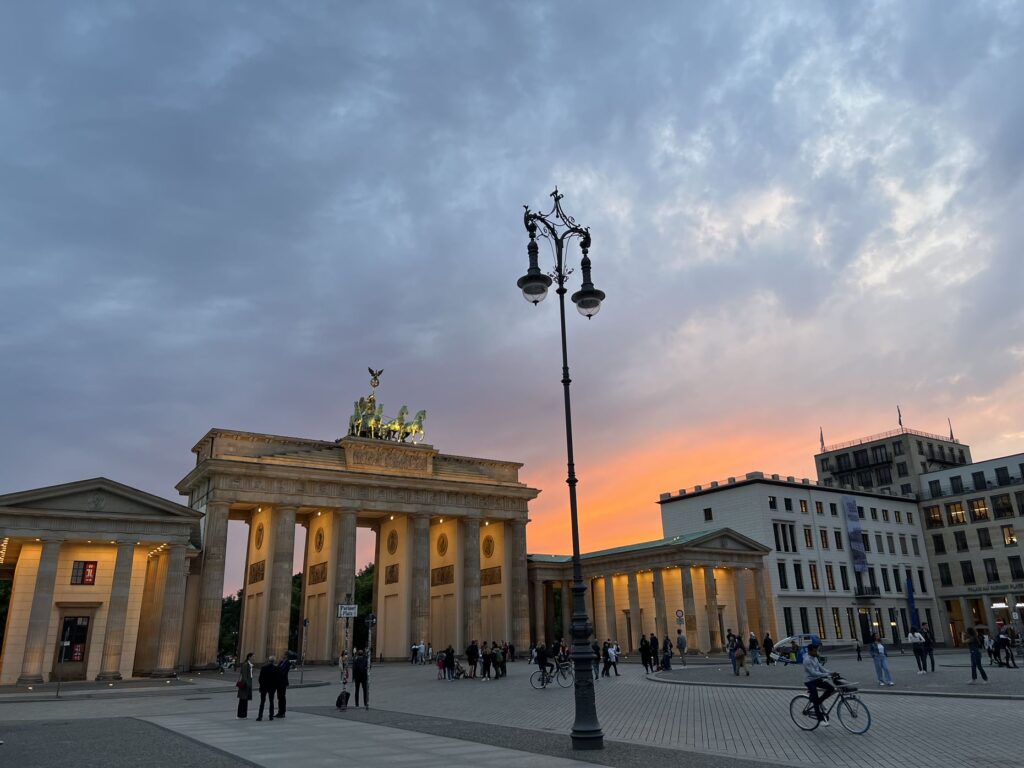
The Brandenburg Gate. (Photo by Patricia Olynyk)
At the Venice Biennale, Braden is caught by the meticulous craftsmanship that “makes the implementation almost invisible in its perfection.” After a year of “throwing things against the wall and seeing what sticks,” he is ready to demand more of himself. He stays a long time at Desastres, an experimental noise project where he is glad to “sit there and just get destroyed by the sound.” Then the group goes to the end of the island, where you can watch ships from Croatia and drink Aperol spritzes and feel the sea breeze on your face—and they enter the Danish Pavilion’s vast exhibit, We Walked the Earth, and Braden forgets where he is. A centaur hangs from a noose anchored in the high ceiling. A female centaur is giving birth, “and she looks so real, and she’s beautiful, but her head is probably one and a half times the size of mine, so it’s intimidating at the same time….”
The exhibit is explained, though that verb denies the deliberate mystery, as “a transhuman attempt to survive in a world where it is no longer enough to be human.” Its strangeness haunts Sharlene Lee, too. She has barely recovered from walking through the Memorial to the Murdered Jews of Europe: “It makes you feel like you are drowning,” she says, explaining that there is utter silence, but “you feel a pressure.” The museum below ground follows the grid of stone columns above, making them “almost like graves.”
A little relief came with the Boros Collection, housed in a World War II bunker that was used to store bananas after the war, then became an S&M club. You can see traces, Lee says with a smile, and I am too shy to ask what they are.
Her medium is video, and in Berlin, she sees it projected not just on square walls, but on ceilings, inside a suitcase, on a sphere, in an abandoned lighthouse. Her next installation, she decides, will have a projection on the floor.
Seeing the Germans’ documentation of atrocity is striking a sharp contrast with her previous work, which focuses on what is not documented—how we often do not even know our great-grandmothers’ maiden names; how the Chinese immigrant culture of Hop Alley was obliterated to build the St. Louis baseball stadium. She listens to what the Nazis did and thinks about what the Japanese were doing to other Asians at the same time—and how Japan, unlike Germany, refuses to admit it. Growing up near Singapore, she saw World War II remembered in broad terms, with no specific acknowledgment of Chinese losses. No nod to the truck that came for her great-grandfather, or the advice to his wife to abort her unborn child, or the waterboarding and force-feeding her other great-grandfather saw.

From the We Walked the Earth exhibit at the Venice Biennale.
Lee writes a seminar paper she titles “Memorial. Monument. Antimonument.” She focuses on the Sook Ching Massacre, the mass killings of as many as fifty thousand “undesirable” ethnic Chinese in southeast Asia by the Japanese occupying army. A graveyard—the largest Chinese graveyard in another country—is being redeveloped. Lee designs a memorial (airy, bright, filled with colorful patterns and motifs from Chinese culture) that could be built during construction.
Looking at Lee’s design, Olynyk smiles and nods. Later, she says quietly, “It’s unbelievable what rises to the surface when the students go on these trips.”
For Yvonne Osei—who just won the Great Rivers Biennial—the idea of amnesia threads through the seminar. “How do we decide to remember?” “Who gets to write the history?” Growing up in Ghana, she saw history embedded in sophisticated ways into the handcrafted art objects that were used every day; symbols woven into textiles, and carved into furniture. She has found life sterile in the U.S., where four hundred years of racism are wiped away too easily. But in Berlin, she happens to glance down at a concrete floor and sees a sentence inscribed, a quote from a letter someone wrote to their family during the Holocaust. “In every single corner, there is some form of memorial,” she muses, “some inscription on the wall, a building with bullet holes preserved to remind us.”
Osei’s work since the seminar has focused on memory and eradication. “There’s a fearlessness in art; you are causing people to question, to remember, to think differently,” she says. One installation, recently exhibited at the Contemporary Art Museum St. Louis, looks at several sites of racial atrocity to learn how they are remembered and used today. One is the gravesite of fourteen-year-old Emmett Till, whose lynching helped spark the civil rights movement. The gravesite was regularly flooded, and the headstone was broken by mowers, the promise to build an Emmett Till Historical Museum betrayed. The family had his casket restored and gave it to the Smithsonian. But Till’s remains are still at Burr Oak, where Osei found weeds, unpaved roads, and a small, insignificant headstone. Osei could feel the collective amnesia, the insistence that “nothing happened,” in that deliberate isolation.
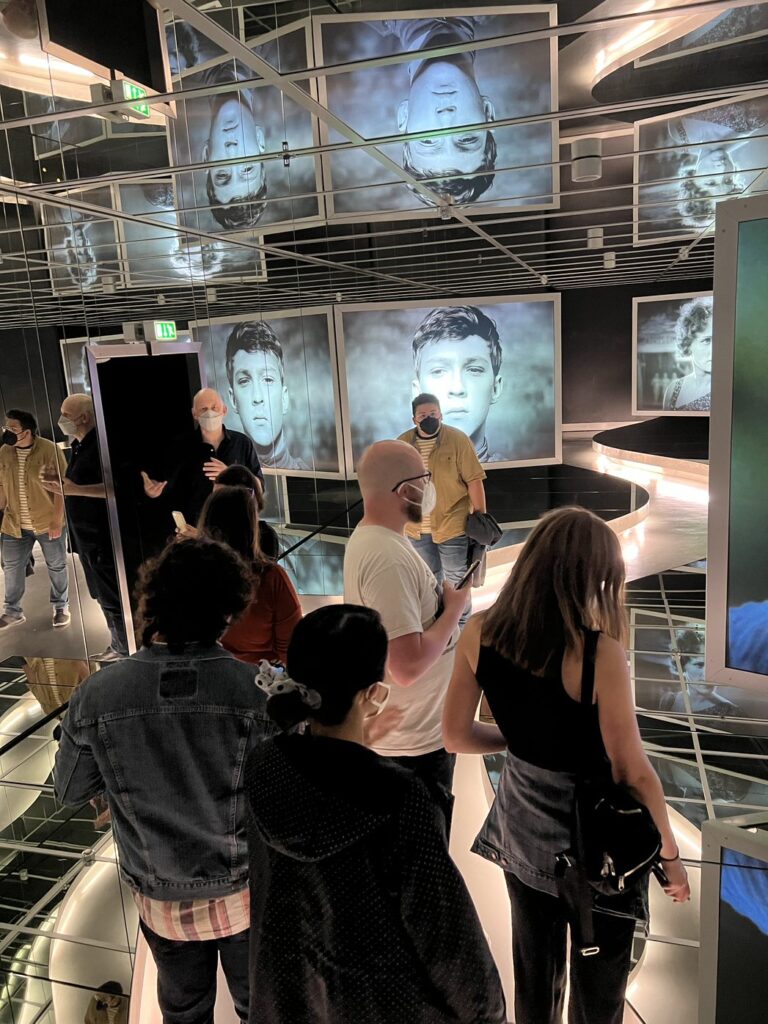
Private tour of Deutsche Kinemathek. (Photo by Patricia Olynyk)
Shirin Rastin, one of many MFA students who chose Washington University because of this seminar, was born in Iran, and her work was already focused on war and postwar traumas. She did the Sommerakademie in 2015, when she was restlessly searching for a new medium. “I was interested in installation, performance, and video art, but I didn’t have a good grasp of it,” she says, “and I didn’t have enough knowledge and confidence to make the shift from drawing and painting to 3D work.” Those weeks in Berlin, exploding with visual information, gave her what she needed. “Right after we returned to St. Louis, my body of work was transformed entirely from 2D to 3D,” she says. “And it happened so naturally and in such a powerful way. New ideas kept coming to me on a daily basis. I loved the new Shirin that was totally calm and in control in her studio.”
The experience inspired Rastin’s final thesis installation at the Kemper Art Museum, Memorial in Exile. For her, the rows of black shoes lined outside barbed wire belonged to political prisoners killed in mass executions in Iran—and commemorated those left behind, living in exile, unable to grieve. When one of the committee members questioned her title, saying it looked more like a monument, she replied without hesitation, “Sir, with all due respect, you are wrong. A monument is a landmark for celebration, a victory. But a memorial is a symbol of remembrance, loss and grieving.”
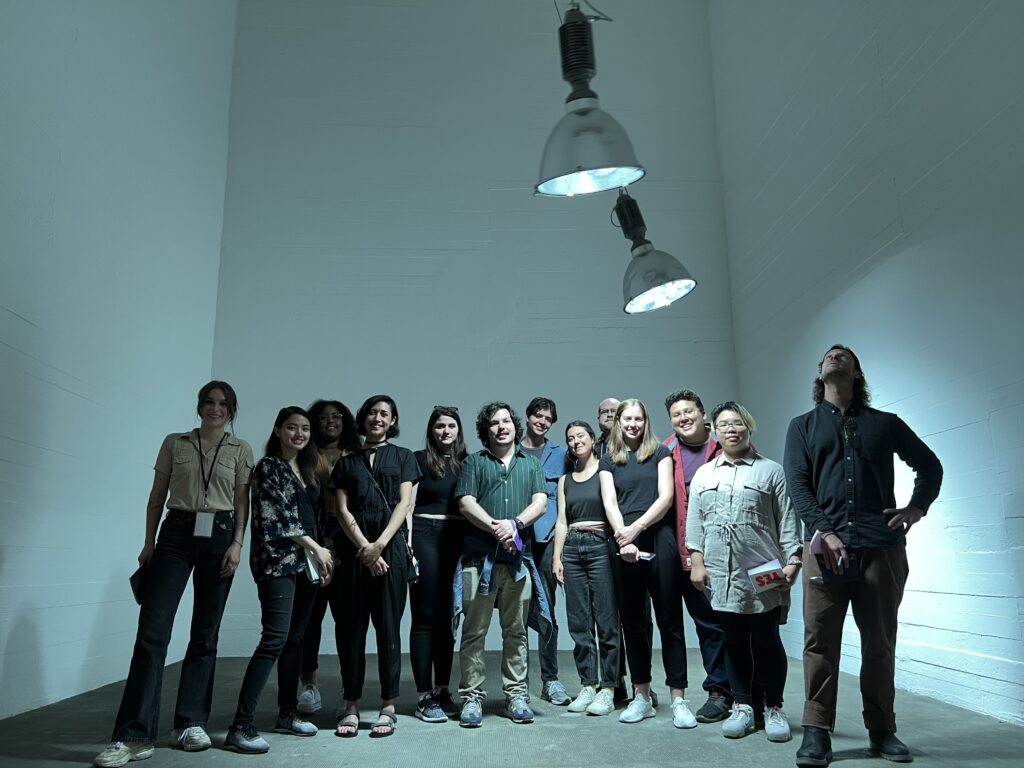
Kinetic light installation in the Boros Collection. (Photo by Patricia Olynyk)
Controversies punctuate the trip. At the Documenta 15 exhibition, a mural is pronounced “Goebbels-style propaganda” by the Israeli embassy in Germany, and federal combat police show up to subdue protests. The piece alludes to claims that Israeli intelligence helped Indonesia’s first president conduct genocide, and the imagery includes a Mossad soldier with a pig’s head and, on the scarf below it, a Star of David. Documenta 15 was curated by an Indonesian collective that had, in a backfired attempt to be inclusive, invited other collectives to select artists—and with no one coordinating, there was nothing to ensure balance. Meanwhile, billionaire art patron Julia Stoschek has come under fire because her great-grandfather was a member of the Nazi party. Was the money funding her collection made from forced labor or made after the war? Had sufficient reparations been made to ease the art world’s conscience?
Questions that might be brushed aside elsewhere. In Berlin, artists ask—and know there are no easy answers.
Read more by Jeannette Cooperman here.
